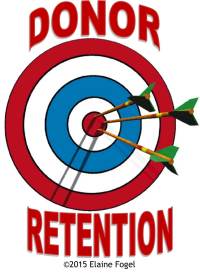Philanthropy
 Many charities depend on fundraising for operational revenue. But, how many could be making more money if they invested in branding?
Many charities depend on fundraising for operational revenue. But, how many could be making more money if they invested in branding?
“Branding?” many ask. “We have a logo. What else is there?”
OMG… so much more! A charity’s brand is way more than a logo, colors, font styles, and its look. It represents every single touchpoint in the organization.
What does that really mean?
Continue reading
 If you work or volunteer for a charitable organization, you may not know that the median donor retention rate in 2013 was only 43%. That means only 43% of donors who made a gift in 2012 did so again in 2013.
If you work or volunteer for a charitable organization, you may not know that the median donor retention rate in 2013 was only 43%. That means only 43% of donors who made a gift in 2012 did so again in 2013.
According to an article in The Chronicle of Philanthropy, based on The 2014 Fundraising Effectiveness Project report, “For every $100 in new donations the 3,576 groups in the survey received in 2013, they lost an average $92 from supporters who failed to give again and others who contributed less than they had previously.”
And, even though the retention rate represents a slight increase over the previous year, it is still a big red flag for charities. It reinforces my saying:
No Marketing. No money. No mission.
 Good news for businesses and charities. About half of American adults say that companies’ social responsibility practices have a strong effect, or sometimes affects, their purchasing decisions and “who to do business with.” Another 25% say it affects their decisions once in a while.
Good news for businesses and charities. About half of American adults say that companies’ social responsibility practices have a strong effect, or sometimes affects, their purchasing decisions and “who to do business with.” Another 25% say it affects their decisions once in a while.
The Harris Poll also shows that one in four Americans feel that people have a personal responsibility to make the world a better place by being actively involved with various issues and causes. An additional 17% feel people should generally take part in things such as voluntary service, donating to charities, or getting involved in community activities because it is the right thing to do.
In addition, the 2013 Nielsen Company report, “Consumers Who Care,” indicates that people’s commitment to spending more on products from socially responsible companies is growing. From 2011 to 2013, Americans’ willingness has grown from 36% to 44%. In Canada, it went from 33% to 38%.
Now, that’s a win-win for both sectors.
Continue reading